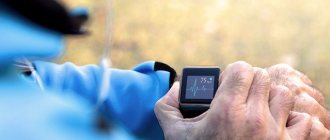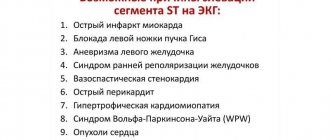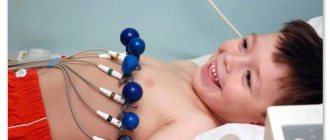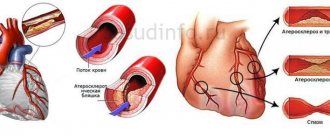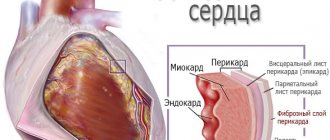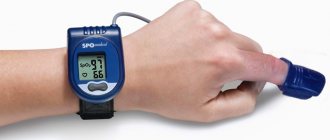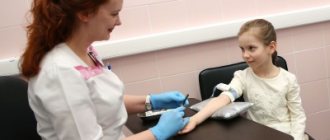Home » Arrhythmia
Category: Arrhythmia
Bradyarrhythmia in children is a pathology of the cardiovascular system, characterized by spontaneous disturbances of the heart rhythm. The clinical sign of the disease is a decrease in heart rate to 60 beats per minute or less. Adequate heart rate: infants - 100 beats per minute, from 1 to 6 years - 80 beats per minute.
If there is a sharp change in the normal heart rate values, the child needs emergency medical care, the untimeliness of which will lead to serious complications and chronic disorders of the heart.
- What is bradyarrhythmia
- Clinical symptoms of childhood bradyarrhythmia
- Principles of traditional and surgical treatment
- Heart rhythm disturbances in child athletes
What it is?
A heart rhythm that differs from normal sinus rhythm is called arrhythmia. If a disturbance in the normal contractile activity of the heart is accompanied by a rapid pulse, this means the presence of tachyarrhythmia. If the heart rate periodically drops to below 60 beats per minute, this condition is called bradyarrhythmia.
This pathology is less common than tachycardia and does not always require therapy. Often develops gradually and is compensated by other body systems.
In the ICD, the disease is called bradycardia and occupies a place in heart rhythm deviations, designated as R00.1. Sinus bradyarrhythmia, as a symptom, can occur in other diseases not related to the heart.
Causes of bradyarrhythmia
Often, bradyarrhythmia in adolescents occurs due to increased tone of the vagus nerve, which is the result of pathologies in the myocardium. Moreover, the pathological state of the myocardium can be caused by several reasons:
- Vegetovascular dystonia. Often this disease provokes bradycardia in children over 1 year of age. Failures of the nervous system that arise against the background of constant nervous tension can develop sinus bradyarrhythmia in a child.
- Heredity. The child may have a genetic predisposition to cardiac arrhythmia. If any family member has had this disease, the risk of its development in the child increases sharply.
- Thyroid dysfunction. Impaired functioning of the thyroid gland can cause many diseases, including bradyarrhythmia. When the thyroid gland malfunctions, iodine deficiency occurs, which, in turn, affects the functioning of the heart muscle. When the iodine content in the body decreases, the heart rate drops. Often, disturbances in the functioning of the thyroid gland are associated with “restructuring” in the body.
- Infections and viruses. For the most part, infectious and viral diseases cannot cause complications in the functioning of the heart muscle, but persistent viruses and infections can provoke the occurrence and development of bradyarrhythmia. Often a sore throat becomes the very disease that causes a decrease in heart rate.
- Self-medication and overdose. It is not for nothing that it is strongly recommended to store medications out of the reach of children, because an overdose can cause complications in the heart.
- Oncology. Malignant tumors in the heart muscle are very rare, but still cause bradycardia. In this case, the disease may periodically make itself felt after rehabilitation.
Attention! If the child loses consciousness, then you need to resort to conservative therapy or implantation of an electrical stimulator.
Symptoms of the disease
Bradyarrhythmia can be compensated or decompensated.
The first form has no clinical manifestations and is not noticeable to humans.
The second form is expressed by the following symptoms:
- Reducing blood pressure to 100/60 or lower.
- Permanent or transient decrease in heart rate.
- Feeling of lack of air, shortness of breath.
- Dull, pressing pain behind the sternum and a feeling of heaviness or emptiness.
- Dizziness when changing position, especially in a vertical position.
- Poor concentration, decreased attention.
- Paleness of facial skin.
- Cold sweat.
- Weakness, lethargy, lightheadedness or faintness.
- Loss of appetite.
- Additionally, there are short-term fainting and general drowsiness with decreased concentration.
Due to the slowing of the heartbeat, the tension in the circulating blood decreases - blood pressure drops. This symptom is present for a short time - subsequently the arteries narrow and compensate for the low heart rate, maintaining a sufficient level of blood pressure.
Episodes of bradyarrhythmia are accompanied by a feeling of lack of air, which, like dizziness, is associated with a deterioration in blood supply to the brain. A person experiences a feeling of fear, panic, and is afraid of suddenly dying. Blood flow in the coronary arteries is reduced and the heart does not have enough oxygen to maintain its function. Because of this, a feeling of heaviness or pain in the chest occurs. The symptom may worsen when taking nitroglycerin.
Symptoms
Only severe sinus bradyarrhythmia of advanced form manifests itself with pronounced symptoms. The moderate variety is characterized by an asymptomatic course, the patient is not even aware of his condition.
Possible clinical manifestations:
- Dizziness (worsens during movement).
- Feeling faint for no reason.
- Heaviness in the chest area.
- Decreased blood pressure levels.
- Muscle weakness.
- Feeling of lack of air.
- Increased sweating.
- Decreased concentration.
- Sleep disturbance – insomnia at night and drowsiness during the day.
- Darkening of the nasolabial triangle.
- Pale skin.
The pathology is discovered accidentally during medical examination or during examination for another reason.
Varieties and factors of their development
By type, bradyarrhythmia has the following classification:
- Functional.
- Organic.
- Toxic.
- Medicinal.
- Neurogenic.
Functional
The occurrence of this change is considered as a natural process in the activity of the cardiovascular system. Moderate sinus bradyarrhythmia, as a rule, is not accompanied by patient complaints, since it does not affect cardiodynamics.
The cause of the phenomenon is the work of parasympathetic innervation, which has relaxing effects on the heart, blood vessels and lungs. Moderately severe bradyarrhythmia is activated during sleep or rest.
This condition does not have pronounced symptoms, so if there are no unpleasant sensations, there is no need to worry. When you wake up or begin physical activity, the heart itself will raise the pulse and restore the normal number of contractions.
Organic
This type manifests itself due to pathological changes in the myocardium or conduction system of the heart.
Has two additional subtypes:
- Sinus bradyarrhythmia or sick sinus syndrome.
- The pathology is not sinus type, with a blockade in the conduction system.
Factors in its development are myocardial ischemia, heart attacks, infectious lesions of the heart and pericardium, and congenital heart defects.
Normally, the automaticity of the heart is controlled by the sinus node, which sets the rhythm of 60-90 beats per minute. The constant generation of impulses in a healthy heart also maintains rhythm. When this node is weak, heart contractions occur less frequently and have an inconsistent rhythm.
With the development of necrotic or dystrophic processes in the heart, its conduction system may be disrupted. The underlying formations begin to act as a pacemaker - the atrioventricular node, bundle branches and Purkinje fibers. Non-traditional pacemakers have a lower rate and do not maintain the correct rhythm. Their signals, mixed with signals from other sources, make the heart rhythm abnormal.
Organic bradyarrhythmia is a life-threatening pathological process and requires therapy, since a low rhythm and weak automaticity can lead to cardiac arrest and death.
Toxic
Bradyarrhythmia of this type develops as a result of the use of poisons or toxins that affect the heart.
Organophosphorus insecticides, ammonia, lead and others can act as cardiac paralytic substances. An overdose of drugs that block the transmission of nerve impulses also causes toxic bradycardia.
Depending on the type of toxic substance, the damage may be reversible or irreversible. Treatment is individual and depends on the type of poison.
Medicinal
Drugs such as verapamil, cardiac glycosides and beta blockers cause bradycardia without disturbing the rhythm.
In this case, the condition is controllable and causes concern only when new drugs are prescribed. However, a medicinal decrease in heart rate below 55 beats per minute is dangerous for health and requires additional correction.
All therapy for drug reduction of rhythm consists of reducing the dose of medication.
Abrupt exclusion of the drug from use is not recommended, since it can provoke an attack of tachycardia, and in the case of taking beta blockers, atrial fibrillation.
Neurogenic
The regulation of the heart is ensured by the autonomic nervous system, which is not controlled by humans.
Sympathetic fibers provide stimulation of body systems, and parasympathetic fibers provide relaxation. Neurogenic bradyarrhythmia occurs due to hyperfunction of the parasympathetic system and lack of action of the sympathetic system.
To treat the pathology, it is necessary to overcome the underlying disease, for example, neurosis or nervous dystonia. The state of vagotonia can be complicated by paroxysms with severe panic attacks.
Children athletes and safety
Parents whose children are actively involved in sports at a professional or close level are concerned about a decrease in heart rate, which can range from 40 to 60 beats per minute. But this condition often turns out to be the norm, and not a pathological change. Sport is associated with high physical stress that a child’s body experiences. Here, sinus bradyarrhythmia should be considered as a natural change. Frequent and long-term training leads to the development of physiological bradycardia. It is completely safe and does not require any treatment. Due to heavy loads, the body compensates for this with less active heart activity during the period when the child is resting and not training. The body independently and consciously reduces the heart rate at rest, which allows the heart muscle to fully relax, recover and gain strength for subsequent activities.
But if the slow rhythm has organic rather than physiological reasons, further exercise and increased stress can lead to dangerous consequences. These are structural changes in the heart muscle, diseases of the endocrine system, problems with the nervous system. If your child is actively involved in sports and encounters manifestations of sinus bradyarrhythmia, for your own peace of mind, take him to a cardiologist and conduct a comprehensive examination. It will show the presence of pathological changes, which will allow you to give up further activities or change your hobby in time. Or the diagnosis will confirm the safety of bradyarrhythmia and will provide the opportunity to continue practicing without fear for the health of your child. Physical education is a variation of sports, only with more gentle loads. Its role is indispensable in the formation of a healthy baby’s body, since it directly affects the state of the cardiovascular system. Excessive activity is dangerous for some and can negatively affect the child’s health.
Before sending your kids to sports clubs, planning his professional sports future, make sure his body is able to adequately perceive increased loads and endure all training conditions.
Why does it occur in athletes?
Physical activity causes the heart rate to increase as a response to a lack of oxygen for muscle cells to function.
With constant movement and stress, the body adapts to hypoxia by increasing hemoglobin and red blood cells. At rest, the heart reduces the heart rate, causing bradyarrhythmia without symptoms, since there is enough oxygen even with rare contractions of the heart.
Most often, this condition develops in runners and swimmers, that is, those athletes who need increased endurance.
Causes and symptoms
There are six types of causes of this pathology.
- Organic. Develops after the formation of stable changes in the structure of the heart muscle. May be caused by ischemia, myocarditis, cardiosclerosis, cardiomyopathy, or myocardial infarction.
- Medicinal. It may appear after an overdose or long-term use of a number of drugs.
- Physiological. It may be a consequence of the proximity of a tumor pressing on the heart muscle.
- Neurogenic. It occurs as a result of a stomach ulcer, brain tumor, or disturbances in the functioning of the nervous system.
- Toxic. It appears as a consequence of severe intoxication of the body during a viral infection. May be caused by hepatitis, typhoid fever or sepsis.
- Pathology of athletes. In people for whom sports is a profession, this condition can occur even in a state of complete rest. This phenomenon is explained by the special rhythm of the heart associated with constant training.
The severity of symptoms corresponds to the severity of circulatory disorders.
Important! The first to suffer from a weakening of the contractile function of the heart is the brain. Insufficient “saturation” of tissues with oxygen, which is carried by the blood, leads to hypoxia - oxygen starvation. The brain is the first to suffer from hypoxia, by the way, as well as from glucose deficiency, and therefore episodes of loss of consciousness are possible, lasting from several seconds to several minutes. Convulsions are possible. These conditions are dangerous and therefore require emergency medical attention - delay can lead to respiratory arrest.
Features of the course in children
Children and teenagers have a faster heart rate, which is required to support their growing bodies.
Children's heart rate norms differ from adults:
| Age | Normal heart rate (beats per minute) |
| Infants up to one year old | 130-150 |
| Children from two to 7 years old | 100-110 |
| Children from 8 to 10 years old | 80-90 |
| Teenagers from 10 to 14 years old | 70-90 |
It should be noted that girls of the same age may have a pulse 10-15 units less, which is explained by the characteristics of the body.
Bradyarrhythmia in children is a less common problem than respiratory tachycardia. Correction is required only if there are pathologies of the heart muscle or a non-standard pacemaker. In the absence of symptoms, the disease is left under observation without treatment.
Long-term violations are also dangerous. If a child was diagnosed with a disease early at 3 years old, and at 4, 5 or 6 years old it did not show any signs of recovery, then he needs to be examined more accurately to exclude organic cardiac pathology.
Low heart rate in a trained person: is it good or bad?
In experienced athletes, in a calm state, the heart slows down, and during physical activity, the contraction frequency increases sharply (up to 260 beats per minute) to more effectively adapt to stress and supply muscles with oxygen. This is their advantage over beginners. Professionals have a well-developed network of capillaries, which, gradually growing, promotes blood supply and nutrition to the hypertrophied myocardium.
However, if the heart size exceeds 1200 cubic meters. cm, a transition to malignant hypertrophy is likely, creating a number of complications in the absence of medical control.
Pathological bradycardia
If training is not structured correctly and the load exceeds the functional capabilities of the body, as well as with concomitant diseases, pathological changes occur in the heart. The faster the heart cells grow, the worse the blood supply to the newly formed areas.
Vascular and nerve cells grow more slowly than muscle cells. Because of this, hypoxia and energy starvation develop. They lead to tissue necrosis - myocardial infarction, with all the ensuing consequences: scarring and possible complications. The sad result of this process is cardiosclerosis and the inability to reach sporting heights in the future.
How is diagnosis carried out?
The main diagnostic method is ECG. An electrocardiogram is performed at rest and during exercise. Based on the conclusion of the cardiogram, the pacemaker and heart rate, repolarization processes of the ventricular myocardium, and the state of atrioventricular and intraventricular conduction are identified.
For newborn babies, electrocardiography is mandatory to check for heart defects, which can cause the baby’s death.
Additionally, echocardiography, or ultrasound of the heart, is performed to assess the size and correctness of its development.
Performing an ultrasound on pregnant women allows us to determine the presence of disorders of the fetal cardiovascular system and provide emergency care immediately after birth.
For an accurate diagnosis, Holter monitoring is additionally performed. For a day, on an inpatient or outpatient basis, a device is installed that measures blood pressure and takes an ECG every half hour. All results are recorded and the resulting code is deciphered by the doctor, confirming or excluding the disease.
The procedures presented above are sufficient to determine physiological bradyarrhythmia.
If other types of pathology are suspected, for example, neurogenic or toxic, the following may be prescribed:
- Biochemical and clinical analysis of blood and urine.
- Bacteriological analysis of feces, urine, blood.
- Analysis of hormone levels.
- Toxicological analysis.
Diagnostics
Severe developing sinus bradyarrhythmia can be diagnosed during a comprehensive examination. Its shape is determined in the same way.
The doctor examines the patient, measures blood pressure, asks about any complaints, and listens to the heart rhythm.
In addition, other techniques are used, such as:
- Electrocardiography. Based on its results, the presence of pathologies is determined and the frequency of myocardial contractions is studied.
- Holter monitoring is continuous electrocardiography throughout the day. In this way, it is possible to detect rhythm disturbances that do not appear during conventional electrocardiography.
- Echocardiography, in other words, ultrasound of cardiac structures. With its help, the doctor studies the cardiac structure and determines the cause of the appearance of the organic form. Such a study reveals an increase in the organ and its sclerotic changes.
- Transesophageal echocardiography is a method of recording an ECG from an electrode placed in the patient's esophagus. This method shows the presence of changes in the structure of the myocardium.
Transesophageal echocardiography
In addition, laboratory blood tests are carried out to determine the level of potassium, magnesium, sodium, and calcium salts.
How is the treatment carried out?
The treatment algorithm is often conservative, since surgical interventions are always risky.
Drug therapy
All medications for bradyarrhythmia are divided into two groups:
- Adrenergic and sympathomimetics.
- CNS stimulants.
Sympathomimetics act on sympathetic innervation, increasing heart rate. The disadvantage of this therapy is the accompanying activity - narrowing of blood vessels in internal organs, dilation of the bronchi, increased sweating.
The use of sympathomimetics should be determined by the danger of the condition.
They should not be taken if:
- hypertension;
- renal failure;
- ischemia of the heart muscle.
Drugs in this series include:
- adrenalin;
- norepinephrine;
- mesatone;
- ephedrine;
- isoprenaline.
CNS stimulants, like caffeine, allow you to reflexively increase your heart rate through general arousal. This approach also has disadvantages - in neurotic disorders this is reflected by a worsening of the course of the disease.
Tablets are also used to increase heart rate:
- Isoprenyl or isoprenaline
- Eufillin
- Ipratropium bromide
- Alupent
- Atropine
At home, you can increase the frequency of contractions with a cup of strong coffee or black tea - the caffeine they contain on average raises the frequency by 10-15 units. Another way is to take a hot bath. If these methods do not help, and the person is still feeling unwell, an emergency call should be made to an ambulance.
As first aid, if necessary, to urgently raise the heart rate, use:
- Adrenalin.
- Norepinephrine.
- Ephedrine.
Drugs in this group are dangerous if used inappropriately and are classified as resuscitation agents.
Bradyarrhythmia is often one of the symptoms of the disease, so the main treatment is always directed to the root cause. A slight decrease in heart rate can also be ignored when taking medications will interfere with the treatment of the underlying pathology.
Pacemaker installation
In case of ineffectiveness of drug treatment, as well as the severity of bradyarrhythmia, the only method of treatment is the installation of a pacemaker. The device generates constant electrical impulses to maintain normal heart function.
Depending on the complexity of the access, the operation is performed either endoscopically or with an incision. Both of these operations are performed under general anesthesia. The pacemaker is connected to the sinus or atrioventricular nodes, ensuring automatic heart function.
Medical contraindications:
- breathing disorders, for example - respiratory collapse;
- endocarditis, pericarditis;
- diseases associated with old age;
- acute infections;
- some mental illnesses.
In children, the main contraindication is their age. The heart is in the process of growth and the installation of a pacemaker will cause severe abnormalities and disability. The child must undergo a full examination, and the recommendation for installation must be fully justified.
Treatment
If the disease is not accompanied by any symptoms, then no treatment will be required. The person does not feel sick and does not even know that any changes are taking place in his heart. In a child, this pathology is temporary, all the more, it is well treated, and with age it goes away on its own. This happens at the age of 7 years.
Therapy is mandatory if a decompensatory form of pathology is diagnosed, when the pulse has decreased due to a serious illness.
Treatment of bradyarrhythmia is carried out in two ways: with the help of medications and surgery.
If an organic, toxic and extracardiac form is diagnosed, then therapy is aimed at eliminating the underlying disease.
The identified dosage form is treated by stopping the medication or adjusting the dosage of the drugs that caused this condition.
Treatment of patients of various age categories is aimed at eliminating the underlying disease.
To restore heart rhythm, it is necessary to use anticholinergic drugs. They can be given intravenously or intramuscularly if the pulse drops too quickly. This method is used when emergency assistance is needed. Other medications that contain potassium are also used.
During surgery, a pacemaker is implanted. It will monitor your heart rate using electrical impulses. After the heart rate normalizes, normal blood supply to the internal organs is restored.
Possible complications
The main clinical complication is cerebral and myocardial ischemia. Constant bradyarrhythmia also affects mental abilities. Complications that may occur due to a slow heartbeat:
- Ischemic stroke.
- Myocardial infarction.
- Pulmonary embolism.
- Paroxysmal ventricular tachycardia.
- Hypertrophy and heart failure.
- Ventricular extrasystole.
A constant lack of blood circulation will cause disturbances in all other organs, and especially in the kidneys, which will lead to renal failure, hypercalciuria and a further deterioration in the automaticity of the heart.
Causes in an adult
Considering the question of what sinus bradyarrhythmia is in an adult and what its causes are, first of all, it should be noted that in adulthood and adulthood the following factors become its culprits:
- inflammatory and degenerative defects of the heart muscle and other organs;
- vascular thrombosis or myocarditis;
- myocardial infarction of the posterior wall;
- deviation in the development of the sinus node;
- genetic predisposition;
- increased intracranial pressure;
- consequences of viral infection;
- oncology;
- hypothyroidism and thyroid pathologies;
- exceeding the dosage of certain medications.
In old age, deviations begin as a result of cardiosclerosis, electrolyte disorders in the blood and ischemic disease.
Prevention
In children, and in adults and adolescents, prevention consists of physical activity. The patient needs to do therapeutic exercises, do exercises, and take walks in the fresh air.
Additionally, you should avoid eating large amounts of animal fats. They are embedded in the cell wall and impair the conduction of impulses through the nervous tissue.
A large amount of vegetables in the diet, rich in calcium and sodium, will also help prevent the development of bradyarrhythmia.
Author of the article: Yulia Dmitrieva (Sych) - In 2014, she graduated with honors from Saratov State Medical University named after V. I. Razumovsky. Currently working as a cardiologist at the 8th City Clinical Hospital in the 1st clinic.


